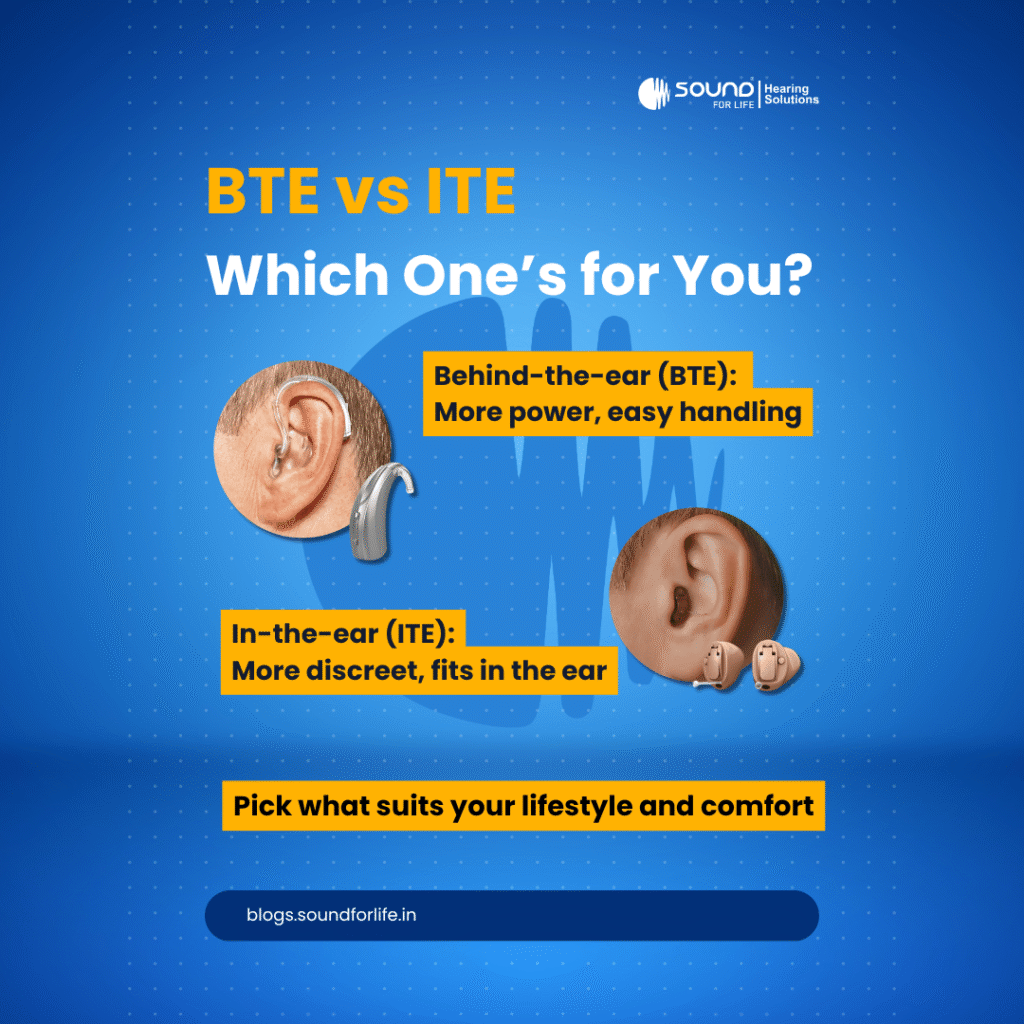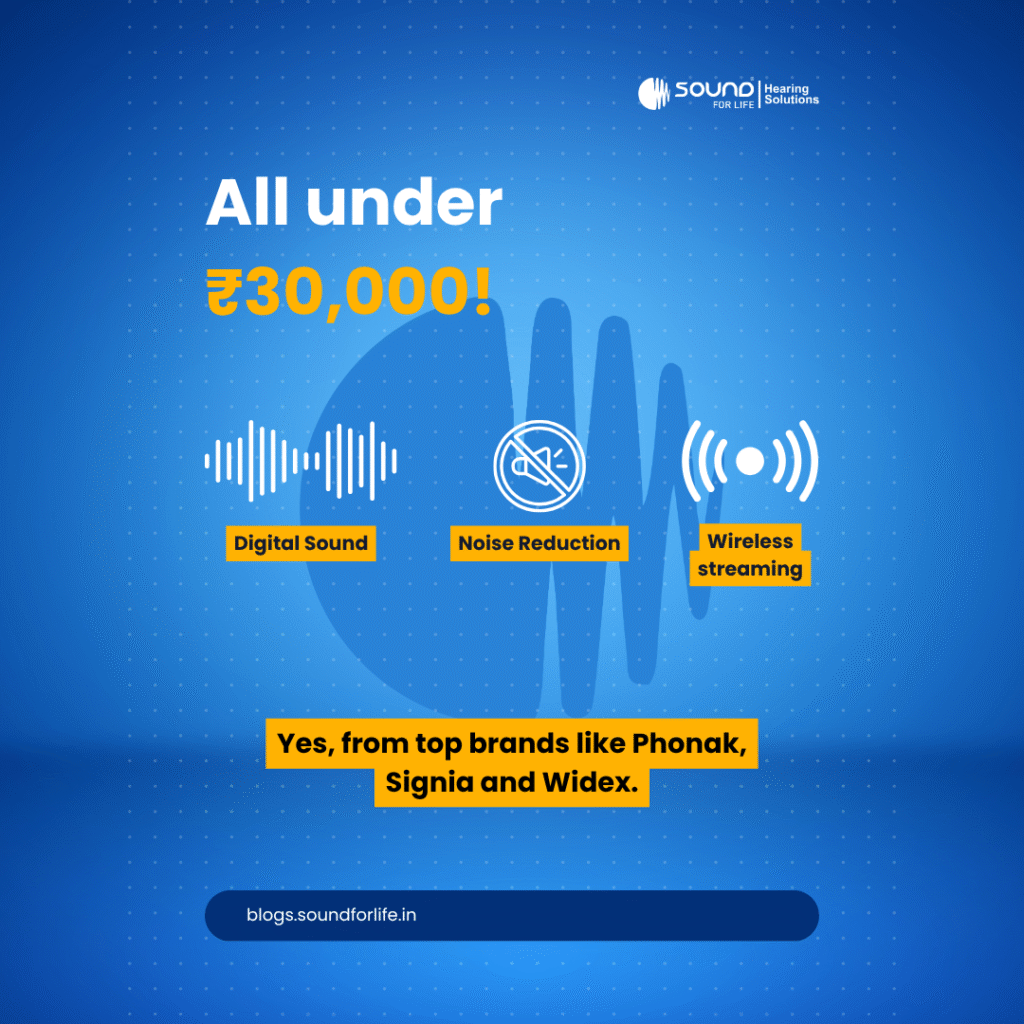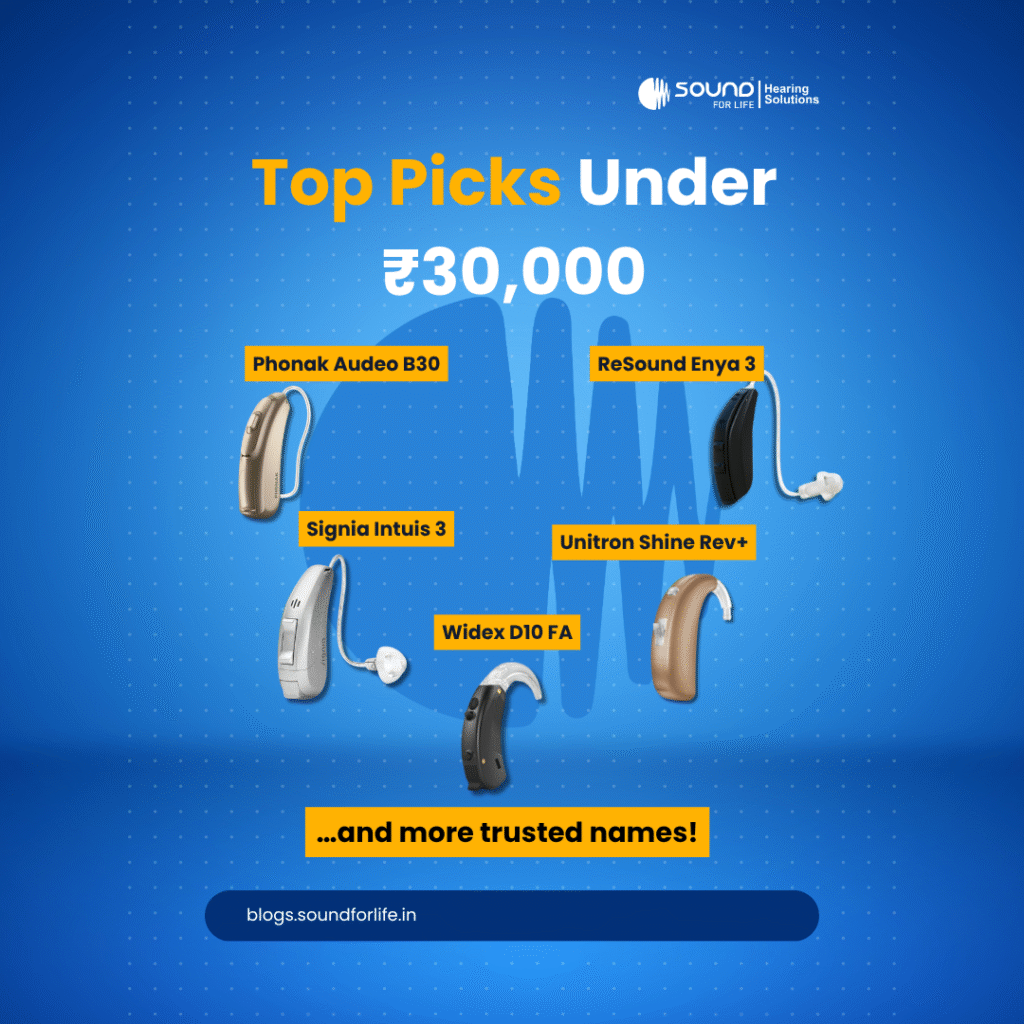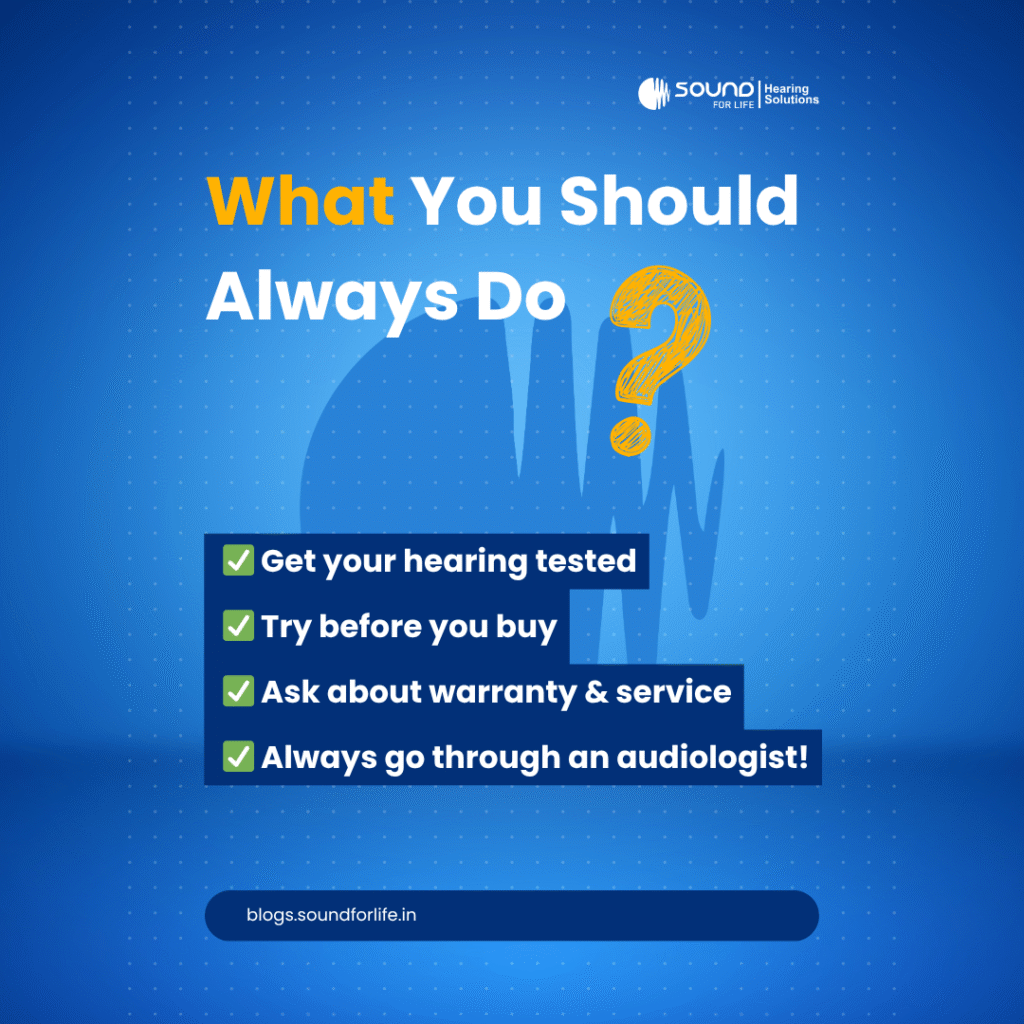Many people assume hearing aids are too pricey, but they can hugely improve your daily life. The good news is that many well-known brands now offer best quality hearing aids for less than ₹30,000. These affordable options still offer digital sound processing, speech enhancement, and even streaming over Wi-Fi. This guide will show you how to pick a hearing aid that won’t break the bank and will also list some of the best options from well-known brands like Phonak, Signia, Widex, ReSound, and Unitron. We’ll go over the most important features, styles, and tips for picking the best hearing aid for you.

How to Pick the Right Style: BTE or ITE
There are two main types of hearing aids: Behind-The-Ear (BTE) and In-The-Ear (ITE). BTE devices rest behind the ear and attach to an earmold or soft dome inside the ear canal. Because the microphone, speaker, and battery sit outside the ear, these models can deliver more power and offer longer battery life. They are also simpler to clean, adjust, and handle than some in‑ear options. According to ReSound, BTE aids are “comfortable because they don’t sit deep in your ear” while still amplifying sound effectively. For those with moderate to severe hearing loss, BTE hearing aids are very often the preferred choice.
ITE hearing aids fit completely inside the outer ear or ear canal. When fitted correctly, these custom-fit devices are very discreet and almost impossible to see. ITC, CIC, and IIC are all styles that go inside the ear. They are smaller and stay in place, which means they pick up less wind noise. Many people with small ears find ITE aids to be more comfortable because they don’t need any extra support. But being small has its pros and cons: ITE aids have smaller batteries, which means they don’t last as long, and they need to be cleaned or maintained more often. You can choose between BTE and ITE based on how well you can hear, how well you can move your hands, and what looks better to you.

What to Look For
Even budget hearing aids today come loaded with smart features. Most digital models under ₹30,000 include multiple listening modes—like one for clear speech in quiet settings and another for noisy environments—plus noise‑reduction technology. Many can also connect wirelessly to the internet. Take ReSound’s entry‑level Enya series, for example: it’s fully wireless, letting you stream calls or music via 2.4 GHz accessories. That means you can link your hearing aid to a microphone or TV streamer without any extra cables. If you’re someone who spends a lot of time on calls or watching TV, look for a hearing aid with at least basic Bluetooth or wireless streaming. This simple feature can make your daily listening much more enjoyable and hassle‑free.
The type of battery is also important. Most basic hearing aids use disposable zinc‑air batteries (sizes 312 or 13) that you’ll need to replace every few days to a week. They are simple to swap but can get pricey over time. Some entry‑level models—like the rechargeable Widex 3 Series—come with built‑in batteries. You’ll pay more at first, but you won’t have to keep buying new batteries. Also, check the water and dust protection rating. Cheaper aids often aren’t waterproof, so avoid wearing them in heavy rain or the shower. Finally, make sure any model you choose comes with a solid warranty and reliable service options nearby. That way, you’ll have peace of mind if anything goes wrong.

Best Affordable Models (Less than ₹30,000)
Here are some well-known hearing aids that cost less than ₹30,000 in India:
Phonak Audeo B30 (RIC/BTE):
The Audeo B30 is Phonak’s low-cost digital hearing aid, and it comes in a Behind-The-Ear (receiver-in-canal) style. It has good sound quality for everyday use and can stream music over Bluetooth with an adapter. The Audeo B30 costs between ₹29,000 and ₹30,000 for each aid in India. This basic model gives good amplification for people with mild to moderate hearing loss. The hook-and-tube design makes it easy to put in, and Phonak’s proven sound processing means that feedback is kept to a minimum and speech is clear. People in India know that Phonak makes products that are well-built and has great customer service after the sale.
Signia Intuis 3 (BTE/RIC):
Signia (by WS Audiology) makes the Intuis 3 series as an entry-level line of hearing aids. Both a behind-the-ear BTE model and a small receiver-in-canal (RIC) model are available. The Intuis 3 RIC (312 battery) and the Intuis 3 BTE both cost about ₹24,990 each, according to price lists. These small devices use 3-channel digital amplification and let you choose settings for different sound environments. They have several programs and automatically change the volume and filtering. Even though they are cheap, they have clear speech processing that works well for everyday conversations in quiet and moderate noise.
Signia (Click-ITE Custom):
The “Click ITE” custom aids in Signia’s basic segment are a fully-in-the-ear option. They are made to fit the shape of your ear canal perfectly, so they fit snugly and aren’t too obvious. Even though they are simple, they all run on the same Intuis platform. According to Signia, their basic line ‘offers products that range from easy-to-learn custom ear moulds to discreet behind-the-ear models’. In real life, these custom ITE aids cost about the same as the Intuis BTE ones. They provide common features like noise reduction and numerous listening programs and cover mild to moderate hearing losses.
Widex BTE D10 FA:
Widex is another global leader that makes entry-level models like the D10 FA. This is a regular behind-the-ear aid with a size 13 battery and four digital channels. It doesn’t have any extra features. A list of suppliers shows that the Widex BTE D10 FA costs ₹30,000.The basic Widex model provides digital amplification and feedback reduction with simple controls. It’s ideal for those who prefer the Widex name without needing Bluetooth streaming or rechargeable batteries. At a budget-friendly price, this entry-level aid still delivers clear, natural sound, making it a reliable choice for everyday listening and features a durable design.
The D10 is powerful enough for people with mild hearing loss, and it comes with a standard earmold.
Widex 3 Series BTE:
The Widex 3 Series BTE is another cheap Widex option. The Widex 3 Series (plastic body, size-13 battery) is listed for sale for about ₹25,000. This light aid has a little more technology. It might have Bluetooth for accessories, multi-channel compression, and a noise tracker. There is also a rechargeable version that costs a little more and comes with a charger that works with it. The 3 Series is a good choice for people with moderate hearing loss because it offers a good balance of price and performance at ₹25,000.
ReSound Enya 3 (BTE):
The Enya from ReSound is an older budget line that is still useful. ReSound’s Enya 3 Behind The Ear model normally sells for the high ₹20,000 range. During sales or clearance of older stock, its price can go as low as ₹30,000. ReSound highlights that the Enya series delivers excellent sound quality and clear speech understanding in a discreet, durable design. Its lightweight body makes it comfortable for all‑day wear. It has features like Adaptive Directionality, which helps you focus on speech, and noise reduction for wind. You can easily change the volume and programs on your phone with Enya and the ReSound Control app. It also works with ReSound’s TV Streamer 2 to stream audio from your TV wirelessly.
Unitron Shine Rev+ P (BTE):
Unitron, which is also part of Sonova, Phonak’s parent company, offers the Shine Rev+ series as an entry-level option. The Shine Rev+ P is a hearing aid that goes behind the ear and costs about ₹24,200. You can get a Shine Rev+ Fit for ₹25,200. It’s a RIC style. These aids have six channels for processing and work well for mild to moderate hearing loss. They are simple, but they have features like a telecoil (for loop systems) and multiple programs (like normal, quiet, and telephone). If you need Bluetooth connectivity, you can add it to Unitron’s apps and streaming devices, like the uDirect streamer.
Other Budget Options:
A lot of other brands also have basic lines. For example, Oticon’s “Dial” series and Starkey’s “Aurora” line often have some devices that cost less than 30,000. Some businesses in the area also sell analogue or digital aids for between ₹10,000 and ₹20,000. But be careful with the warranty and follow-up support for devices that aren’t as well known. All of the picks above are from well-known companies that have good service networks in India, which is important for fitting and maintenance.

Advice on buying and what to do next
Want to buy a hearing aid for less than ₹30,000? Here are some ideas:
Try It Before You Buy:
Always try out a hearing aid before you buy it. A good clinic will let you take it home for a few days to try it out. For instance, SFL Hearing Solutions lets you try their products risk-free, so you only pay if you notice a real difference.
Get a Hearing Test:
First, have an audiologist check your hearing. This tells you exactly how much amplification you need. The audiologist can then suggest models (or programs) that are right for your hearing.
Battery Type:
Check what kind of battery powers the aid. Basic models use zinc-air batteries that can be thrown away (sizes 312 or 13). If you want rechargeable batteries, be aware that they usually cost a little more than ₹30,000.
Connectivity:
If you use a smartphone or watch TV a lot, choose an aid that can connect to the internet wirelessly (Bluetooth or a streaming accessory). Even simple Bluetooth streaming for calls can make things a lot easier.
Warranty and Service:
Make sure the warranty lasts for at least one to two years. Make sure there is a local service centre or clinic that is authorised. Big cities have authorised stores for major brands like Phonak, Signia, Widex, ReSound, and Unitron.
Professional fitting:
A hearing aid that fits well makes a big difference. Get help from an audiologist to set up and fine-tune the device. If you don’t set them up right, the best hearing aids in the world won’t help.
Affordable hearing aids today use advanced digital processing, so even at lower prices they can significantly improve clarity in conversations and reduce background noise. The models listed above have all been vetted by audiologists and are stocked by hearing centers in India.
Do you want to hear better?
If you want a free consultation, get in touch with SFL Hearing Solutions, India’s top multi-brand hearing clinic. Audiologists at SFL have these brands in stock and can show them to you in person. They offer free hearing tests and trials with no risk (you only pay if you decide to buy). Call SFL Hearing Solutions or go to their website to find out more. Book your free evaluation today to find out which hearing aid under ₹30,000 is best for you. This is the next step towards clearer hearing.





